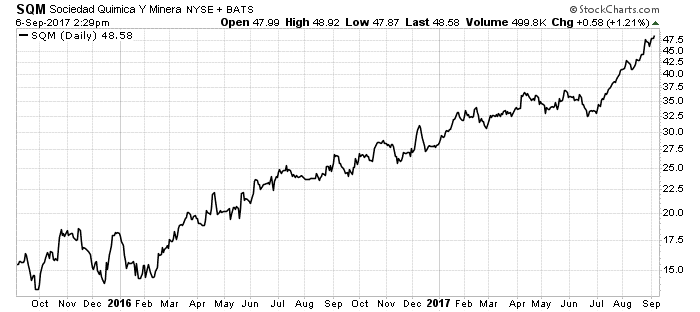The Future Of Lithium Production Is Dirt Cheap Right Now
According to cosmologists, three elements formed from the Big Bang, before stars, galaxies or planets. They are hydrogen, helium and lithium.
Lithium’s the 33rd most abundant element in the earth’s crust, far more common than lead, tin, uranium or silver. However, until recently, demand for lithium was quite low.
According to metal price monitor Metalary.com, a ton of lithium cost $1,460 in 2005. By 2010, it rose to $4,350 per ton.
The price really began to take off in 2014. It went from $5,050 per ton that year to $9,100 per ton today.
In just 12 years, the price of a ton of lithium went up 523%.
That’s fantastic. It’s a bull market in lithium. The rapid rise and soaring demand prompted the iconic metals clearinghouse London Metals Exchange to add lithium to its exchange. That would be a huge improvement in the lithium market.
Today, there is no real set price for lithium. The fragmented market crosses countries and industries. That makes it hard to figure out profitability of a mine or a company…

There’s a Lot of Lithium Around
There’s an old trope in the commodity world:
The cure for high prices … is high prices.
The meteoric rise in lithium prices spurred a massive interest in the metal. Companies sprang up all over the world. And they found lithium. Lots of it.
More importantly, they found brine.
As I said earlier, lithium is a common element in the earth’s crust. As mountains weather, lithium metal washes out.
Lithium salt is a common ingredient in brines. A brine is a concentrated salt solution. We find it associated with ancient seas, desert lakes and oil fields. There is a lot of it around.
Mining brine looks like a huge growth area for lithium production.
Brine Mining Isn’t New
MGX Minerals Inc. (CNSX: XMG) is the largest lithium brine permit holder in Canada. The company just launched a new division, called PetroLithium Corp. of America.
It will focus on recovering lithium from oil field brines. Some of these brines hold a lithium concentration of 700 milligrams per liter. That works out to 1.78 tons of lithium per Olympic-size swimming pool.
Brine mining isn’t new. It began back in the 1930s as a byproduct of the oil industry.
For example, it produces over 10,000 tons of bromine in South Arkansas alone. In 2013, wells there pumped over 11.2 billion barrels of brine, according to the Arkansas Oil and Gas Commission.
This is the future of lithium production because it doesn’t need to be mined, and it’s already an industry.
Room to Expand
So lithium production has a lot of room to expand. That’s good because it needs to.
Demand forecasts are ridiculously high thanks to battery-powered cars. That’s the spur that’s fueled the bull market in lithium producers like Sociedad Química y Minera de Chile (NYSE: SQM):

As you can see, this stock is up 200% since January 2016. The interesting thing is that in July 2017, the price increase shifted into a much steeper climb. This could be a blow-off top in lithium.
If you have big profits in lithium stocks, tighten your stops. If you hit your stop, sell and take the profit.



